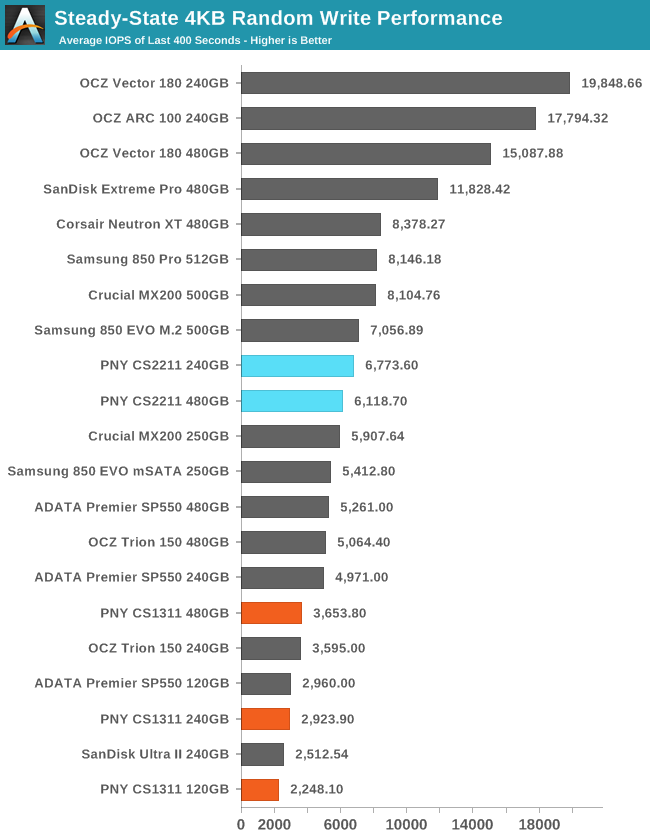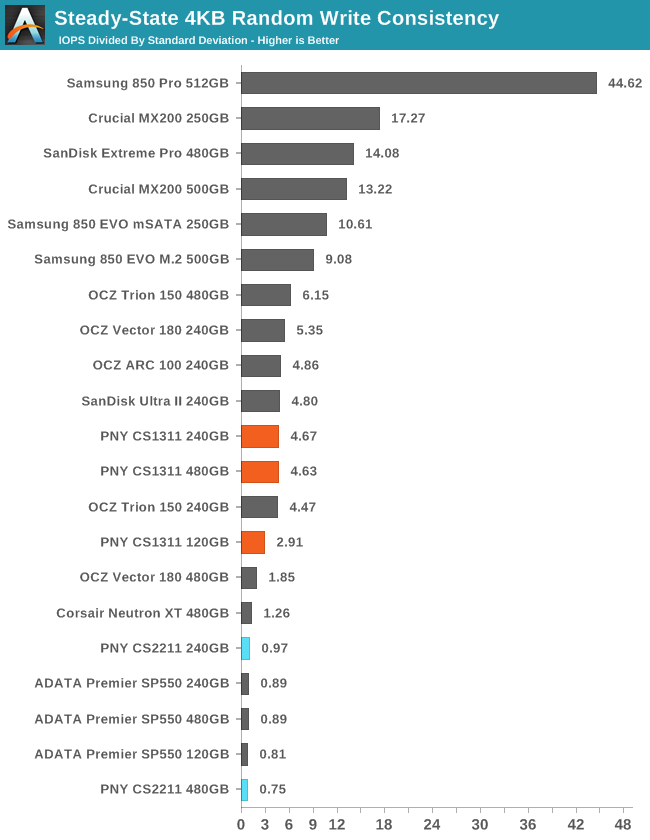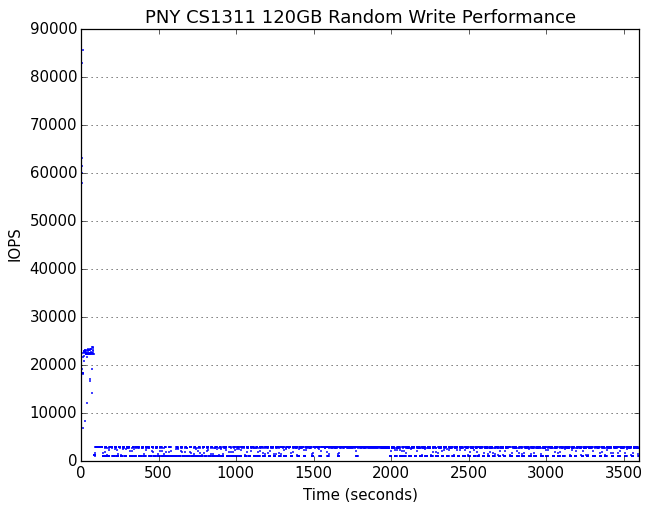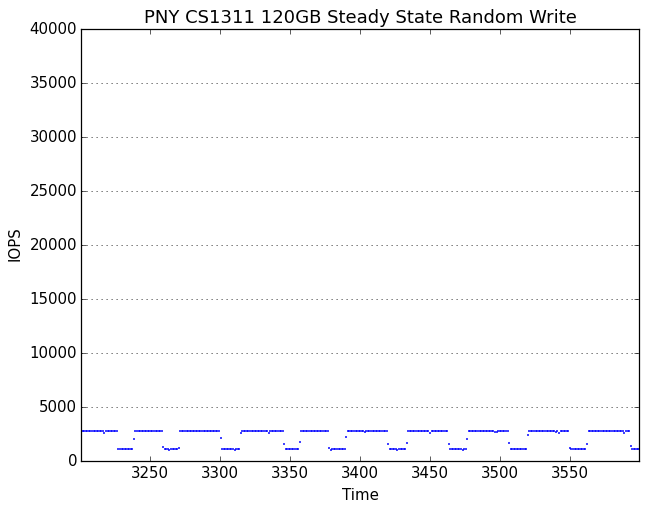The PNY CS1311 and CS2211 SSD Review: MLC vs TLC at 15nm
by Billy Tallis on April 15, 2016 8:00 AM ESTPerformance Consistency
Our performance consistency test explores the extent to which a drive can reliably sustain performance during a long-duration random write test. Specifications for consumer drives typically list peak performance numbers only attainable in ideal conditions. The performance in a worst-case scenario can be drastically different as over the course of a long test drives can run out of spare area, have to start performing garbage collection, and sometimes even reach power or thermal limits.
In addition to an overall decline in performance, a long test can show patterns in how performance varies on shorter timescales. Some drives will exhibit very little variance in performance from second to second, while others will show massive drops in performance during each garbage collection cycle but otherwise maintain good performance, and others show constantly wide variance. If a drive periodically slows to hard drive levels of performance, it may feel slow to use even if its overall average performance is very high.
To maximally stress the drive's controller and force it to perform garbage collection and wear leveling, this test conducts 4kB random writes with a queue depth of 32. The drive is filled before the start of the test, and the test duration is one hour. Any spare area will be exhausted early in the test and by the end of the hour even the largest drives with the most overprovisioning will have reached a steady state. We use the last 400 seconds of the test to score the drive both on steady-state average writes per second and on its performance divided by the standard deviation.

Among TLC drives, the ADATA SP550 and OCZ Trion 150 both soundly outperform the PNY CS1311 in sustained random writes. The PNY CS2211 performs well enough for a cheap MLC drive, but is also significantly behind the earlier Phison-based Neutron XT. The gap between the CS2211 and the CS1311 is clear, but there are other MLC and TLC drives blurring that line.

The CS1311's consistency score is decent despite the low overall random write performance. The CS2211 has a very low consistency score, indicating that there's a major difference in firmware between the two models. We would normally expect ongoing garbage collection to be easier for a MLC drive, especially one with as much spare area as a typical TLC drive.
 |
|||||||||
| Default | |||||||||
| 25% Over-Provisioning | |||||||||
The difference in behavior between the the CS1311 and CS2211 is very clear. The TLC-based CS1311 has the tight regulation of performance we saw on the OCZ Trion 150 while the MLC-based CS2211 behaves like earlier Phison-based drives by having a solid baseline with widely varying performance above that.
 |
|||||||||
| Default | |||||||||
| 25% Over-Provisioning | |||||||||
The 240GB CS1311 and 240GB Trion 150 alternate between the same two performance states, but the Trion 150 spends a far larger portion of its time in the higher performance state. At the 480GB capacity, the Trion 150's slower performance state is the CS1311's faster state.
The CS1311 responds better to overprovisioning than the CS2211, leading to the 480GB CS1311 providing a steady 10k IOPS while the CS2211 varies from 3k to 27k IOPS.










43 Comments
View All Comments
futrtrubl - Saturday, April 16, 2016 - link
How is that not good enough? That's 3 years if you rewrite the ENTIRE drive EVERY DAY.Let's pick a long 9 year planned lifetime for a drive as you would probably want to upgrade by then for non-failure reasons. That means you could write 1/3 of the drive's capacity every day for those nine days. For a 256GB drive (somewhat on the small end now) that's 85GB every day. Or installing 2-3 AAA games every day!
bug77 - Sunday, April 17, 2016 - link
Well, on a modern OS you no longer control the amount of data being written. Automatic updates, indexing, metadata, restore points... the OS will write those whenever it wants to.If planar TLC was half the cost of MLC or V-NAND TLC, I may consider it. But since it's within 10-20%, I'd rather get the better drive.
doggface - Tuesday, April 19, 2016 - link
The average laptop user writes 10-20gb a day. Even if you were double average you would still be safe as houses.BrokenCrayons - Thursday, April 21, 2016 - link
I have a modern OS on my laptop and have quite a bit of control over what does or doesn't get written to storage. For instance, there are no restore points, indexing is mine to manage as I see fit. I can pick when and what I want to update, and I haven't allocated a partition to swap (thank you Linux). You just have to exercise a bit of selectivity about which modern OS you decide to install.rarson - Monday, April 18, 2016 - link
In my experience, the average mechanical hard drive has a life of about 2 years. I see many of them fail before then, and most of the drives these that last over 5 years are already 8+ years old.I recently bought one of Seagate's 8TB archival drives and it started making some clicking noises right out of the box. It hasn't given me any problems yet, but it is a bit disconcerting to hear a click every couple minutes. Hard drives just don't last very long anymore, while my SSDs have been rock solid with everyday use. I would not install my operating system on a mechanical drive ever again. No reason to do so.
fire400 - Monday, May 23, 2016 - link
i put windows XP on this 1311, and it's the fastest I've ever seen XP do anything, startup, tasks, and installing software and launching programs, faster than high end workstation systems on HDD's, since it's debut in 2001... loland yes, the XP OS is extremely stable because the 1311 takes care of garbage collection in the background.
burn tested it for several hours and days on end, it's perfect...
LB-ID - Friday, April 15, 2016 - link
I can't imagine buying any PNY products in any event, but even more so given that the Samsung EVO is so much more bang and reliability for your buck.DigitalFreak - Friday, April 15, 2016 - link
Every PNY device I've had, whether SD cards or video cards, has died prematurely. Absolute garbage.The_Assimilator - Friday, April 15, 2016 - link
That's what the "XLR8" part stands for!TheinsanegamerN - Wednesday, April 20, 2016 - link
My pny 770s are going strong 2.5 years later. Also some of the coolest running 770s I've seen